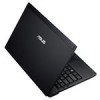Asus B23E User Manual - Page 24
HDMI Port, USB Port 3.0, Microphone Input Jack
 |
View all Asus B23E manuals
Add to My Manuals
Save this manual to your list of manuals |
Page 24 highlights
4 HDMI HDMI Port HDMI (High-Definition Multimedia Interface) is provided for transmitting uncompressed digital-audio and video signals from DVD players, set-top boxes, and other audiovisual sources to television sets, projectors, and other video displays. It can carry high quality multi-channel audio data and all-standard, high-definition consumer electronics video formats. HDMI display devices utilize transition minimized differential signaling (TMDS) to carry audiovisual information through the same HDMI cable. 5 USB Port (3.0) The USB (Universal Serial Bus) port is compatible with USB 3.0, 2.0, or USB 1.1 devices such as keyboards, pointing devices, cameras,hard disk drives,printers,and scanners connected in a series up to 4.8Gbits/sec (USB 3.0), 480Mbits/sec (USB 2.0), and 12Mbits/sec (USB 1.1). USB allows many devices to run simultaneously on a single computer, with some peripherals acting as additional plug-in sites or hubs. USB supports hot-swapping of devices so that most peripherals can be connected or disconnected without restarting the computer. This port also supports USB Charger+ function that helps charge the connected USB device even when the Notebook PC is powered off. Refer to the later section for details. 6 Microphone Input Jack The mono microphone jack (1/8 inch) can be used to connect an external microphone or output signals from audio devices. Using this jack automatically disables the built-in microphone. Use this feature for video conferencing, voice narrations, or simple audio recordings. 24 Notebook PC User Manual















